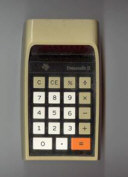
DATAMATH CALCULATOR MUSEUM
 |
DATAMATH CALCULATOR MUSEUM |
Texas Instruments SR-11 Version 1
| Date of introduction: | September 11, 1973 | Display technology: | LED modules + lens |
| New price: | $119.95 | Display size: | 8 + 2 |
| Size: | 6.3" x 3.1" x
1.5" 158 x 78 x 38 mm3 |
||
| Weight: | 9.2 ounces, 262 grams | Serial No: | SR-11 011469 |
| Batteries: | 3*AA NiCd | Date of manufacture: | wk 40 year 1973 |
| AC-Adapter: | AC9200, AC9130 | Origin of manufacture: | USA |
| Precision: | 8 | Integrated circuits: | TMS0602, 2*SN75493, 2*SN75494 |
| Logic: | Chain | Displays: | DIS115E (12*DIS279) |
| Memories: | |||
| Program steps: | Courtesy of: | Joerg Woerner | |
| Download manual: | |
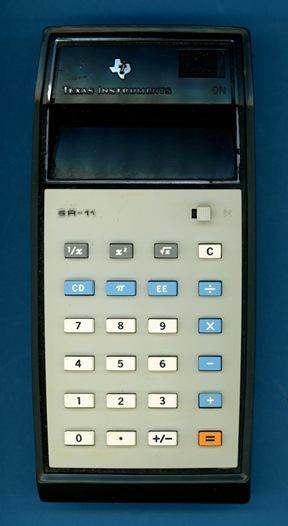
![]()
![]() The
SR-11 calculator added a constant-switch and PI to the wedge shaped predecessor SR-10.
More notable was the new layout of the keyboard, with the SR-11 Texas
Instruments introduced the smaller keys known from todays calculators. Compared
to later models the keyboard was colorful arranged, the last calculator with
blue and orange keys was the SR-50.
The
SR-11 calculator added a constant-switch and PI to the wedge shaped predecessor SR-10.
More notable was the new layout of the keyboard, with the SR-11 Texas
Instruments introduced the smaller keys known from todays calculators. Compared
to later models the keyboard was colorful arranged, the last calculator with
blue and orange keys was the SR-50.
Texas Instruments announced on September 17, 1971 with the TMS1802NC the first available standard calculator building block on a chip, it was later renamed into TMS0102. The chip integrates 3,520 Bits Read-Only program Memory (ROM, 320 Words x 11 Bits), a 182-bit Serial-Access Memory (SAM, 3 Registers * 13 Digits, 2 * 13 Bit-Flags) and a decimal arithmetic logic unit as well as control, timing, and output decoders but no drivers for the display. These function blocks of the chip add up to an overall complexity of roughly 5,000 transistors and marked in 1971 with its die size of roughly 230 mils * 230 mils (6 mm * 6 mm) the limits of a chip for commercial manufacturing.
While the 3-Register Serial-Access Memory of the TMS0100 series of single-chip calculator circuits is large enough to realize a basic four-function calculator with independent memory, couldn't the engineers fit the necessary code into the 320-Word Read-Only program Memory of the device and Texas Instrument started to manufacture in 1973 calculators like the Montgomery Ward P8M with chips from their competitor Western Digital.
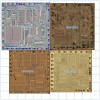 With the the numbers of transistors in Large-scale Integration
(LSI) chips roughly doubling every two years, Texas Instruments decided
for the successor of the TMS0100 family to expand into three
different branches:
With the the numbers of transistors in Large-scale Integration
(LSI) chips roughly doubling every two years, Texas Instruments decided
for the successor of the TMS0100 family to expand into three
different branches:
|
TMS0600: Increased ROM (384 Words x 11 Bits), Identical SAM (13 Digits Registers), external display drivers. Process shrink, higher functionality TMS0700: Identical ROM (320 Words x 11 Bits), Identical SAM (13 Digits Registers), external display drivers. Process shrink, identical functionality, cost reduction of IC TMS0800: Identical ROM (320 Words x 11 Bits), Reduced SAM (11 Digits Registers), integrated segment drivers. Process shrink, reduced functionality, higher integration |
The first two designs using the TMS0600 single-chip calculators with its additional 64 Words of program code can be found with the TI-2550 (TMS0601) adding both a 4-key Memory and percent function to the TMS0100 based TI-2500 Datamath and this SR-11 (TMS0602) adding a Constant switch and a [pi] key to enter the value of pi to 8 significant digits (3.1415927) to the TMS0120 based SR-10 calculators.

 Dismantling the featured
SR-11 manufactured in
October 1973 by
Texas Instruments in the United States reveals a complex design with three
printed circuit boards (PCBs) for main electronics, display, and keyboard
powered by three AA-sized rechargeable NiCd batteries. The Main-PCB sports not
only five familiar looking Integrated Circuits (ICs) but a myriad of discrete
components in a from the Datamath well known arrangement:
Dismantling the featured
SR-11 manufactured in
October 1973 by
Texas Instruments in the United States reveals a complex design with three
printed circuit boards (PCBs) for main electronics, display, and keyboard
powered by three AA-sized rechargeable NiCd batteries. The Main-PCB sports not
only five familiar looking Integrated Circuits (ICs) but a myriad of discrete
components in a from the Datamath well known arrangement:
|
Calculating Unit - TMS0602 single-chip calculator circuit Display Driver - 2*SN75493 Segment Drivers and 2*SN75494 Digit Drivers Clock signal generation for TMS0602 with discrete components Power converter with discrete components and transformer 21-pin connector to the Display-PCB 15-pin connector to the Keyboard-PCB |
![]() Calculating Unit: The
SR-11 makes use of the TMS0602 single-chip calculator circuit derived from the TMS1802,
better known as first "calculator-on-a-chip" but with a Read-Only program Memory
increased from 320 Words to 384 Words x 11 Bits.
Calculating Unit: The
SR-11 makes use of the TMS0602 single-chip calculator circuit derived from the TMS1802,
better known as first "calculator-on-a-chip" but with a Read-Only program Memory
increased from 320 Words to 384 Words x 11 Bits.
Comparing the feature sets of the TMS0119 (TI-2500), TMS0601 (TI-2550), TMS0120 (SR-10) and TMS0602 (SR-11) shows the limitations of the TMS0100/TMS0600 and explains the move from Texas Instruments towards architectures with scalable ROM configurations like the TMS0200 Building Blocks for Desktop Calculators introduced in 1973 but most important to the TMC0500 Building Blocks for Scientific and Programmable Calculators introduced with the "Slide Rule" calculator SR-50 in January 1974 and leading all the way to the legendary TI Programmable 59 and the amazing SR-60A Prompting Desktop calculator:
| Features/ Device |
[0]...[9] [.] |
[+] [−] [Χ] [χ] [=] |
[+/−] | [C] [CE] | [CONST] | [F/2/4] | [%] | [Memory] | [EE] | [1/x] | [x2] | [√x] | [PI] | Display Format |
| TMS0119 | * | * | * | * | * | E88888888 | ||||||||
| TMS0601 | * | * | * | * | * | * | * | E88888888 | ||||||
| TMS0120 | * | * | * | * | * | * | * | * | E88888888-88 | |||||
| TMS0602 | * | * | * | * | * | * | * | * | * | * | E88888888-88 |
![]() Display: With the TMS0100
and its successor TMS0600 originally developed for portable and desktop
calculators supporting either an 8-digit or 10-digit output with a leading negative
sign/overflow indicator, these chips consequently support only 11 digit outputs
for the display but the SR-11 obviously uses a 12-digit
display for:
Display: With the TMS0100
and its successor TMS0600 originally developed for portable and desktop
calculators supporting either an 8-digit or 10-digit output with a leading negative
sign/overflow indicator, these chips consequently support only 11 digit outputs
for the display but the SR-11 obviously uses a 12-digit
display for:
|
1: Overflow indicator, negative sign Mantissa 2-9: 8-digit Mantissa 10: Negative sign Exponent 11-12: 2-digit Mantissa |
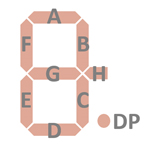
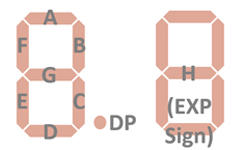 Reverse-engineering
the SR-11 schematics reveals a simple trick used by Texas Instruments to control
its 12-digit display with only 11 digit outputs of the TMS0602 and known already
from the second version of the SR-10: The unused "H"
segment available on the TMS0602 was repurposed for the minus sign of the
Exponent in the pictured (pictures on the left) way. Every time the "H" segment
output of the TMS0602 is activated, some additional circuitry on the PCB will
enable both the digit driver for the negative sign of the Exponent and the
segment driver for the "G" segment of Digit 3 (counted from right to
left) of the DIS115E Twelve-Digit display
module while the "G" segments of all other digits are activated by the "G"
segment output. Hence you'll find 21 connections between the Main-PCB and the
DIS115 Display-PCB:
Reverse-engineering
the SR-11 schematics reveals a simple trick used by Texas Instruments to control
its 12-digit display with only 11 digit outputs of the TMS0602 and known already
from the second version of the SR-10: The unused "H"
segment available on the TMS0602 was repurposed for the minus sign of the
Exponent in the pictured (pictures on the left) way. Every time the "H" segment
output of the TMS0602 is activated, some additional circuitry on the PCB will
enable both the digit driver for the negative sign of the Exponent and the
segment driver for the "G" segment of Digit 3 (counted from right to
left) of the DIS115E Twelve-Digit display
module while the "G" segments of all other digits are activated by the "G"
segment output. Hence you'll find 21 connections between the Main-PCB and the
DIS115 Display-PCB:
|
12 connections for Digit 1 to Digit 12 1 connection for Segments G of Digit 3 1 connection for Segments G of Digit 1, Digit 2 and Digit 4 to Digit 12 6 connections for Segments A, B, C, D, E, and F of Digit 1 to Digit 12 1 connection for Decimal Point of Digit 1 to Digit 12 |
The featured SR-11 manufactured in October 1973 uses a DIS115E Twelve-Digit display module with 12 individual DIS279 Seven-Segment displays and an integrated magnifying lens.
![]()
![]() Display Driver: The Main-PCB of the featured
SR-11 manufactured in October 1973 makes use of a total of four Display Drivers. The two
SN75493 Segment Drivers for four segments, each and the two
SN75494 Digit Drivers for six digits, each are improvements of the original
SN75491/SN75492
chips introduced with the TMS1802 but allow for operation at lower voltages.
Display Driver: The Main-PCB of the featured
SR-11 manufactured in October 1973 makes use of a total of four Display Drivers. The two
SN75493 Segment Drivers for four segments, each and the two
SN75494 Digit Drivers for six digits, each are improvements of the original
SN75491/SN75492
chips introduced with the TMS1802 but allow for operation at lower voltages.
Clock: While the nominal clock frequency of the TMS0600 single-chip calculator circuit is specified with 250 kHz, uses the SR-11 a slower pace to reduce overall power consumption of the product slightly. The astable multivibrator using two discrete transistors operates at a frequency between 150 kHz and 250 kHz, we observed with a featured SR-11 manufactured in February 1974 a clock frequency of 244 kHz.
Texas Instruments introduced in August 1973 with the TI-2500 Version 3 the approach of a dynamic switching of the clock frequency for the TMS0100 single-chip calculator circuit to conserve power between calculations. The astable multivibrator idles at a frequency of around 50 kHz but increases with the detection of a depressed keybutton for a short time to about 200 kHz to reduce execution time of the operations. Two diodes are connected between the keymatrix inputs KN (numbers) and KO (operations) and the oscillator to catch every entry of a number or function keys for a impressive reduction of power consumption.
Power Supply: The SR-11 is powered by three AA-sized rechargeable NiCd batteries resulting in a typical voltage between 3.0 V (completely depleted cells) and 4.5 V (while charging full cells). The Main-PCB hosts a power converter circuit centered around an astable multivibrator, step-up transformer and various diodes and capacitors to generate the supply voltages for the TMS0602 chip and the clock oscillator. We observed in a featured SR-11 manufactured in February 1974 rather high output voltages of VSS = 8.4 V and VGG = -9.0 V for the electronics.
Battery Saver Circuit: To save battery power the LED display turns off automatically between 15 and 60 seconds after the last keyboard entry, except for the first digit (Digit D3 of TMS0602, LSD of Mantissa). If the display turns off while entering a problem, the display turns on automatically with the first keyboard entry. Depressing the [=] key brings back the last calculated display. Three diodes are connected between the keymatrix inputs KN (numbers), KO (operations, [pi]) and KP ([1/x], [x2] and [sqr X]) and a simple monoflop to catch every entry of a number or function keys to keep the Digit Drivers enabled. If the monoflop time expires, the Digit Drivers sans Digit 3 are disabled for an impressive reduction of power consumption:
| Mode | Display | Current VBAT = 4.5 V |
Clock Frequency |
| Calculating | 0 | 62 mA | 244 kHz |
| Power Save | 0 | 62 mA | 244 kHz |
| Calculating | E88888888-88 | 138 mA | 244 kHz |
| Power Save | 8 | 74 mA | 244 kHz |
Keyboard: The Klixon type keyboard uses much smaller keys than the SR-10 calculator in the same extreme wedge-style of the housing that was adopted for the scientific desktop calculators SR-20 and SR-22, too. The last portable scientific calculator with this wedge-design was introduced in October 1974 with the SR-16.
 The appearance of the SR-11 changed during the life cycle
(around May 1974) of
the calculator slightly and together with a change of the twelve individual
Seven-Segment displays used for the DIS115 display module, we differentiate between
three different SR-11
Versions manufactured in the United States between September 1973 and October 1975:
The appearance of the SR-11 changed during the life cycle
(around May 1974) of
the calculator slightly and together with a change of the twelve individual
Seven-Segment displays used for the DIS115 display module, we differentiate between
three different SR-11
Versions manufactured in the United States between September 1973 and October 1975:
| Version | Display Type |
Displays for DIS115 |
Constant Switch |
| SR-11 V1D1 | single modules with lens |
DIS279 | Small Cap |
| SR-11 V1D2 | single modules with lens |
DISXXX | Small Cap |
| SR-11 V2D2 | single modules with lens |
DISXXX | Large Cap |
Here at the Datamath Calculator Museum we classify the featured SR-11 as Display Type 1 and Small Cap for Constant Switch.
![]() While
Texas Instruments prototyped some SR-11 calculators with two LED-modules (Light Emitting
Devices) known already from the Datamath
calculator, are all known series SR-11 using twelve individual Seven-Segment
displays for the DIS115 display module.
While
Texas Instruments prototyped some SR-11 calculators with two LED-modules (Light Emitting
Devices) known already from the Datamath
calculator, are all known series SR-11 using twelve individual Seven-Segment
displays for the DIS115 display module.
The SR-11 was not only manufactured in the United States, but in Italy and Spain, too.
It took 12 years and a similar scientific calculator with just the [1/x], [x2], [√x] and [PI] keys appeared, don't miss the unusual TI-18 SLR.
![]() Press the X-RAY button and view the
internals of a SR-11 calculator.
Press the X-RAY button and view the
internals of a SR-11 calculator.
(Pictures provided by Edward Soudentas)
If you have additions to the above article please email: joerg@datamath.org.
© Joerg Woerner, December 17, 2021. No reprints without written permission.